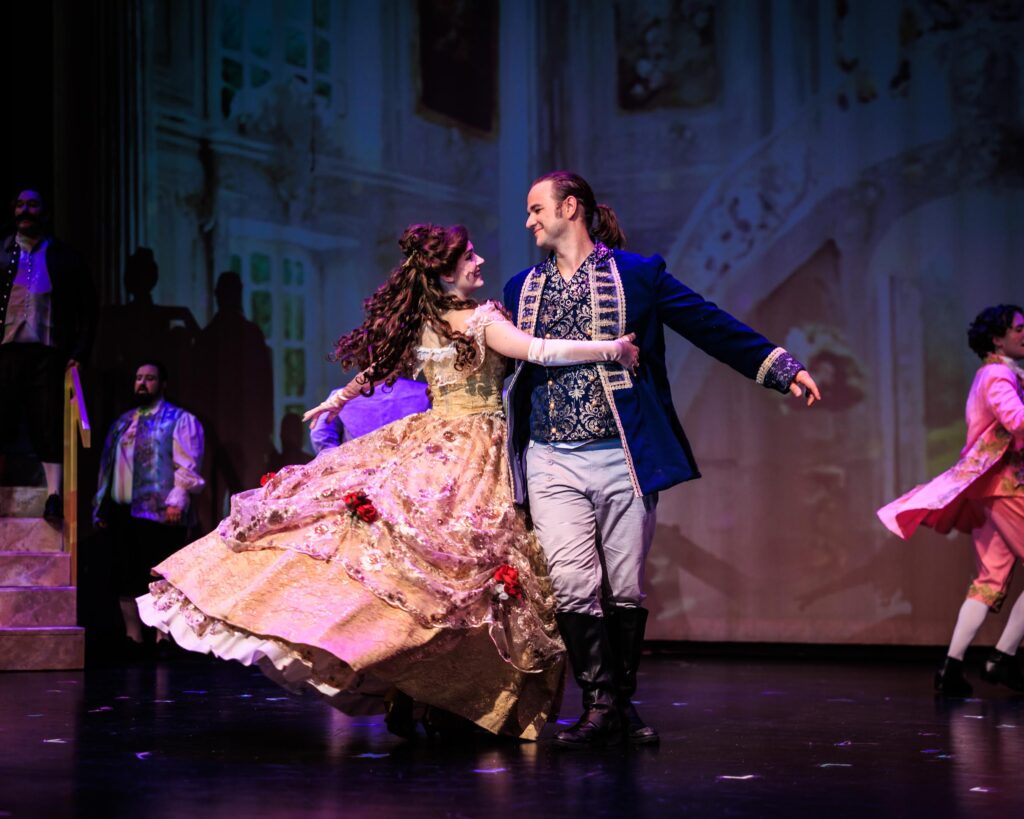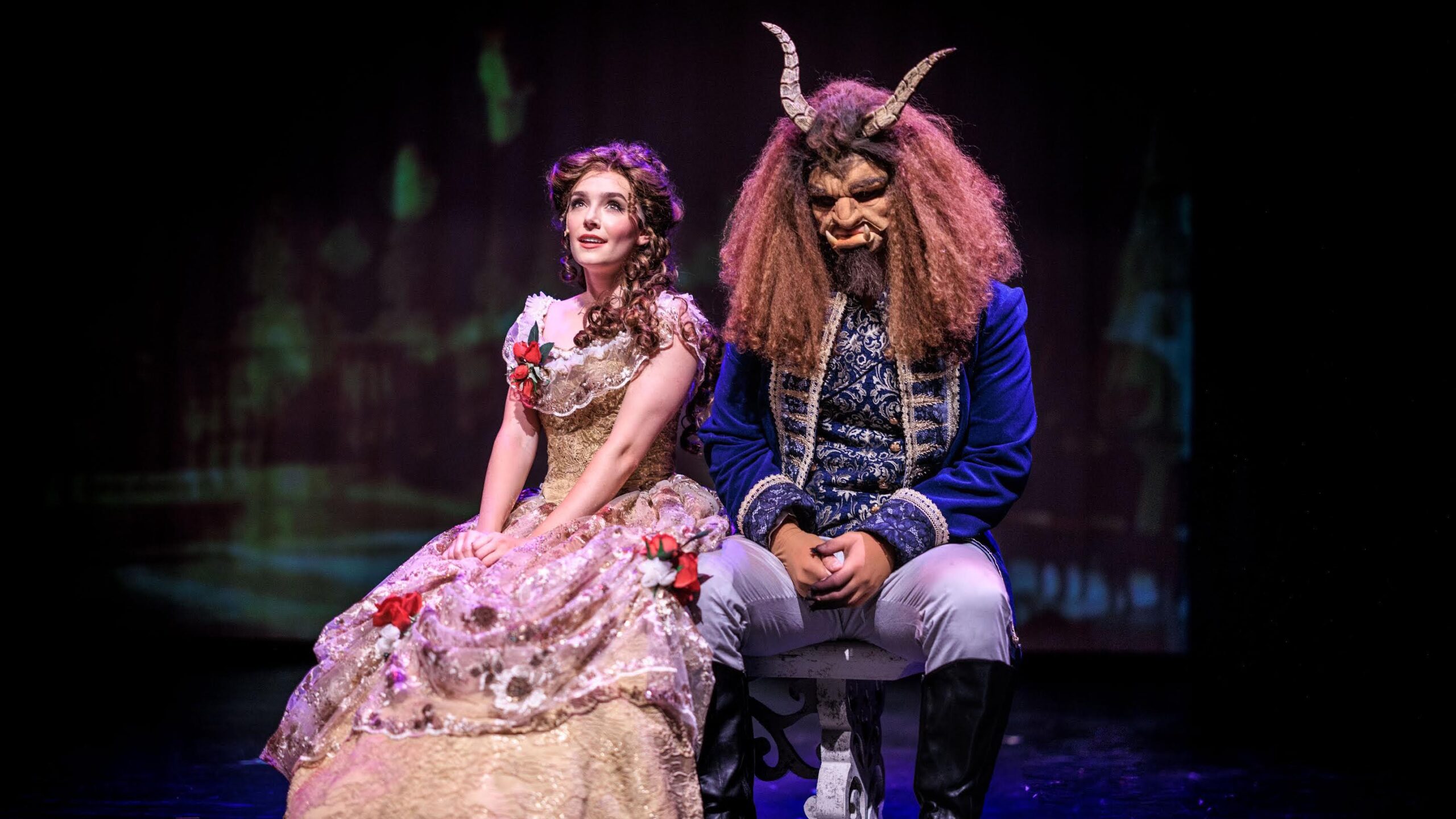COTTONWOOD HEIGHTS — Beauty and the Beast, the broadway musical with book by Linda Woolverton, music by Alan Menken and lyrics by Howard Ashman and Tim Rice, is a large undertaking for any theatre, but for a small community theatre, it can surely be a beast of a production. However, that didn’t stop Cottonwood Heights Arts Council from taking it on and putting it in director Brighton Sloan’s capable hands.
As I entered the auditorium on opening night I was pleasantly surprised to see a full orchestra seated in front of the stage at Butler Middle School. It is not often that I’ve seen a live orchestra at local community theaters, certainly not often enough given the bounty of local musicians and orchestras in the Salt Lake area. Producing a musical with a live orchestra is challenging, but the depth it brings can be sufficiently rewarding that it is well worth the endeavor. The orchestra, led by Dr. Robert Bedant, is excellent and the live music elevates the production to a beautiful interplay between cast and musicians in a way that a canned track will never accomplish.
The casting and performance of Cottonwood’s production are excellent. Summer Sloan Alvey as Belle is up to the task both as an actor and vocalist. Jin-Xiang Yu as Mrs. Potts demonstrates her superb vocal ability in the theme song during the “Beauty and Beast” dance sequence. And Zaan Kathal Yufox as Chip is delightful. At first I wondered if they’d cast too young of an actor in the role, but Yufox proves he is not just cute, he is a talented young actor. He delivers his lines clearly and loudly, picks up his cues and makes his entrances and exits. The entire cast is delightful and generally very strong both vocally and physically—but the true stand out is James Carter as Lumiere. Carter’s outrageous French accent, comic timing and delivery, and commitment to the character and his arc are delightful to watch.
Generally, the staging and choreography are mostly well done. There are moments where the choreography (by Heather Sessions-Gaillard) gets a bit muddled when the entire cast is on stage—in particular when a moment is happening with principals downstage and the ensemble is dancing directly upstage such as parts of “Gaston” and “Be Our Guest”, making the large stage feel too crowded. These moments would benefit from greater use of the sides of the stage rather than staging everything in the center.
Despite this, “Be Our Guest” is a delightful number and generally the choreography throughout the production is fun and appropriate. Similarly, Sloan’s blocking and staging is fairly clean, other than a few moments when actors seem to get pinned into a space, such as anything staged inside the tiny upstairs rose/west wing set piece, or when Lumiere is oddly staged behind a large candelabra at the beginning of “Be Our Guest”. That said, these small struggles are far outweighed by the successful moments. Two wheeled staircases are used to great effect in the fight scene as Belle tries to reach Beast and stop Gaston. A particularly creative element is the casting of a ballet dancer (Sidney Brown) to portray the enchanted Rose. Dressed with a rose-esque headpiece, stemlike green corset and skirt evoking red rose petals, Brown dances in and out of scenes throughout the production, losing petals from her skirt. It’s an inventive choice and works very well visually.

The production design excels most in Lauri Baird’s costuming. The costumes are fun and flamboyant and evocative of the beloved Disney movie without trying to entirely recreate the film. Beast’s half mask and jaw prosthetic are clever and excellently done and do not inhibit the actor’s ability to speak and sing—which allows the audience to connect with the character. Mrs. Potts, Cogsworth and Lumiere are delightfully costumed, especially Lumiere who is typically costumed with giant candles in his hands. However in this production, the character is dressed in a fitted luminescent tailcoat with shoulders fitted with melted wax and several lighted candles. This creative costume allows the actor the free use of his hands. Ensemble costuming is delightful, from the townspeople to the dinnerware with tall colorful wigs and corsets bedazzled with cutlery, creating a visually festive production from start to finish.
The sound balance in the production is lacking. In addition to microphones being generally muddy, it was extremely difficult to hear and understand the ensemble’s individual lines. It was hard to tell if the issue was the equipment (or lack of) or the sound operation, but with the lead actors’ microphones working well, it is jarringly unbalanced to suddenly be straining to hear the other side of interactions they have with other characters. Hopefully this was just an opening night foible that can be overcome as the run progresses. The challenge of sound balancing is definitely made greater with the presence of an orchestra as it is difficult to ensure the actors can be heard over the musicians, even if the company is outfitted with state-of-the-art microphones.
I sat in the elevated rear section of the auditorium during the first half of the show, and moved down into the main level at intermission and found that the sound was better there—I believe this is both because the sound operation got better as the production progressed, but also because I was better able to hear the ensemble parts. It is general admission, so I recommend arriving early to pick a good seat. Main floor seating towards the back seemed to offer the best balance between orchestra and vocals.
Set design by Bill Fox includes a multitude of wheeled panels and doorways that are artfully used by Sloan to transition from place to place, often moving around and with the actors in such a way that the next scene magically coalesces around them. These delightful transitions are an excellent example of how to use minimal set for a big impact. Unfortunately, the show also uses a large upstage screen for near-constant projection of realistic scenery—from a provincial street scene, to a pub and castle; these projections were unnecessary at best and distracting at worst. The clever set pieces are sufficient that the projections detract from the show rather than add to it.
There were moments, such as the can-can section in “Be Our Guest”, where colorful, moving lighting is projected onto the large screen—a fun addition—only to get washed out when layered over the scene projection. Other moments where the screen is mostly just awash in color suggest what might have been had the production simply utilized broad color washes and occasional gobos to project simple shapes or patterns on the upstage screen instead. Although much can be forgiven in the technical elements of community theatre, I believe it behooves smaller productions to lean into simplicity (like the rolling set pieces) rather than striving to mimic complexity (like the projections) and falling short.
Finally, during intermission and post-show, a large iconic image of the Beast and the rose are projected onto the curtain. I was surprised at the impact such a simple projection had and believe that projecting it preshow would have a similar mood-setting anticipatory impact.
Sloan’s director’s note says this is a story of transformation, and she accomplishes that, not just in the transformation of the Beast, but in Belle’s transformation too. Belle sings “No change of heart, a change in me” as she comes to realize how much she cares for the Beast, indicating a transformative rather than a transactional change. Sloan also discusses the endurance of the show. The animated version was released more than 30 years ago, yet Beauty and the Beast endures in children’s hearts still today. Cottonwood Heights’s Beauty and the Beast is a captivating and accomplished community production of this timeless classic.
[box]Cottonwood Heights Arts Council’s production of Beauty and the Beast runs July 12-13, 15 and 18-20 at Butler Middle School Auditorium (7530 S. 2700 E. Cottonwood Heights). Tickets are $10-12. For more info, visit cottonwoodheights.utah.gov.[/box]
